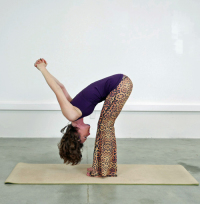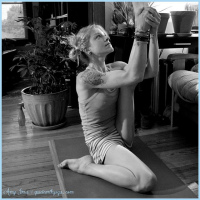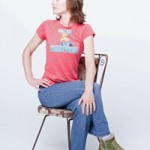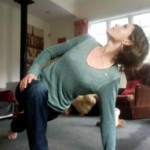by Kara-Leah Grant, Musings from the Mat
One Sunday recently I retired to the beach for 90 minutes to work my way through a set yoga sequence a friend had posted on their Facebook page.
It was total luxury. My son was with his uncle, I had no-where to be and nothing to do, but soak up the sun, the salty breeze, and washing sound of the waves while immersing myself in a yoga sequence.
I hated it.
Oh, not the scene, or the setting, or the child-free time but the sequence. From the perspective of anatomy there was nothing wrong with it – it was a well-rounded, logical sequence that challenged in all the right ways.
However, for my body it reinforced my tightness, highlighted my weaknesses and triggered my insecurities.
Yet, while I hated this particular yoga sequence, this wasn’t a bad thing. Nor was it a bad thing even though the sequence mostly reinforced my tightness.
Doing new and different postures was educational.
In particular, Heron Pose, something I have never done before in my life, highlighted the extreme difference between my left and right side due to something going on in my right hip.
Sitting with my left leg bent I could find my way into the posture and work with the breath. My right leg was at about 45 degrees and my spine felt open and long.
Sitting with my right leg bent I couldn’t even begin to lift my left leg off the ground without toppling over sideways to the left.
This fascinated me, and after I finished the set sequence, I segwayed into my usual practice – breath-led, exploratory, and generally very slow.
I sat in the set up for Heron with the right leg bent and investigated exactly what was going on.
Why was I tipping to the left?
Ah… the right hip seemed to roll inwards, with no release out and down. I swapped legs and investigated what happened on the left. There was ease and the hip dropped out and down effortlessly.
Why didn’t it drop on the right?
Back to that side for some more deep breathing into the hip to investigate. Was it bone on bone? Was it muscular? Was it alignment? Was it tension held in the psyche?
I explored and played with small tidal movements seeing if I could free the hip manually.
This exploration rolled on to about twenty minutes of working with this one particular posture on one side. Afterward ,I felt more free and light.
Yet… Even as I worked with my body, I could also feel those other thoughts arising in me. The ones that go something like this:
- What’s wrong with me?
- I’ve been practicing yoga for 15 years or more now, why is my body so stiff?
- What have I been doing wrong?
- Why doesn’t my body open up?
- What’s wrong with me?
- When is it going to change? When am I going to change? When am I going to find ease?
Yes, I am the inflexible yoga teacher. At least, given the body of experience and practice I have, that’s how I see myself. I should be bendy and free by now? Right?
Yet this is not my journey. Achievement and ease in postures is not where my success lies. In many ways, total acceptance of myself as I am, tightness and all, is where my success lies. And paradoxically, this apparent weakness also becomes my strength.
It becomes the way I teach yoga – not as achievement of posture, but as a way to meet yourself on the mat and accept yourself as you are, today.
It’s the only way I can teach, because that’s the journey I’ve travelled and am still travelling.
Yet it doesn’t mean I don’t yearn for competency in posture as well. But if I’m honest with myself, I don’t train for competency in posture. If I really cared about opening my body and getting into the tough postures I could put myself through far more rigorous asana training.
But I don’t – partly because I don’t believe it’s going to make much difference, and partly because it makes me feel like shit when I constantly do things I can’t do.
But I know that if I did do those things I can’t do repeatedly, I’d probably get better at them and then love them. Such is the nature of challenge and learning.
Instead, I find ways to practice that allow me to access my tightness with more ease and release. This method does work.
I might not do a difficult posture for six months and then go back into it and discover that I’m now at ease within it because of all the other work I’ve been doing.
However, I could train with far more dedication towards physical competency.
Why haven’t I? Partly because I’ve had so much time of feeling like shit that getting on to my mat and doing things that also make me feel like shit was not only not appealing, but not healthy. I needed to feel my strengths on the mat, not my weaknesses.
In the midst of my life, which felt like it was lurching from crisis to crisis for about ten years (excrutiating back pain, psychosis, heart break, recovery from psychosis, an abusive relationship, single parenthood) yoga wasn’t about achieving physical prowess but about surviving the day without drowning in the depths of despair.
Consequently, I understand yoga and the psyche intimately, and I understand how the most powerful thing we can do in life is to accept and open to ourselves as we are in each moment.
Plus the exploratory, breath-led way I approach asana means I understand how to open the body in such a way that leads to postures, rather than just understanding postures which are a result of opening the body.
Despite all of this, practicing asana that highlights my weaknesses brings up those thoughts of inferiority and insecurity.
I want to feel strong and open and free in my body.
And I do, when I practice in a particular way.
However, it is not how I feel when I practice in other ways.
Which is why it is so important that I practice set sequences like my friend’s at least once a fortnight.
I need to get out of my comfort zone and experience my body through the lens of those postures. I need to see where my weaknesses are and where I might be avoiding myself on the yoga mat.
It’s all too easy to just do what feels good, especially when we’re doing a home yoga practice.
This can be good – it lifts us up and makes us feel great and gives us the a buzz on the mat. But if we only do what feels good we risk an unbalanced practice and we lose out on the opportunity to play with our edge.
Now, as my life eases off somewhat and I have more time to practice and more access to teachers I admire, I’m contemplating working more deeply with my body.
Part of me wonders what the point is – hell, I’m 39, if fifteen years of yoga hasn’t opened it up by now maybe it’s time to just accept this is who I am.
This is true.
But what is also true is that every time I explore and breath into the tight parts of my body, taking time to sit with them and understand them, I’m also loving my body. I’m loving me. Out of that might arise more physical openness, but more importantly though, out of that arises more compassion and acceptance for myself as I am. Paradoxically, this becomes the positive feedback loop.
I am flawed and broken yet I am perfect and whole just as I am.
I can sit with both of these on the mat, work with both of these on the mat.
This is my yoga – defined not but how flexible I am, but how open I am to being with myself as I am.
Will I ever be a flexible yoga teacher? Does it matter? Surely what matters most is how much I love myself for who I am?
And that, it appears, I am still working on.
Can I teach yoga even though I’m often tighter than my students?
Hell yes – because what I’m teaching isn’t postures, it’s a way to be with oneself and a way to be with life. The postures are the tool we use to explore this new way of being, until is becomes the default both on and off the mat.
Yoga is not flexibility. It is presence. It is awareness. It is who we are when our minds cease.
That is yoga.




Hi Kara-Leah,
I’ve just read your Conundrum of the inflexible yoga teacher and you have inspired me. I have been practicing yoga for 10 years and have often thoght of becoming a yoga teacher but my flexibility and balance is not as good as many I see in class. (Yes I know I should not compare myself to others). I now realise it does not have to be but I can teach the whole philosophy of yoga, it is more than just the asanas. Thank you for allowing me to pull down this barrier I had put up for myself.
LT
Hey L,
Yes absolutely – teaching yoga as about far more than the asana. Plus, when the posture doesn’t come easy to you it often means you spend more detailed time on it in your home practice which leads to a far better understanding of how the postures open than if you’re easily able to assume the position.
Good luck!
KL
What a beautiful read… thank you so much for sharing this story. You are yoga, no matter how flexible you are. I am a stiff yogi too, even after so many years of practise, but it doesn’t matter. What is flexibility anyway? It’s so much more than just our bodies right?:)
Thank you for sharing.
Hey Claudia,
It’s so easy to know that on an intellectual level… but bringing the knowing down into the heart & body seems to take more work. It’s another thing completely… and something I’m still learning, despite all the intellectual knowing.
Kara-Leah, this is such a brilliant post, you’ve really nailed it. I have been reading and working a lot this year around the idea of self-acceptance and perfectionism and motivations for change – there is so much going on in our heads. I think this post is a strong illustration of one of the concepts you’re getting at in No More Excuses, that yoga is about coming to know ourselves, not achieving some external benchmark.
But, I also think you are so right that it’s important not to just rest in our comfort zone. Every so often (like you say, two weeks or so) it’s good to take an inventory and see where resistance or old habits may be creeping in. This applies physically, but also emotional/thinking/relationships, a whole host of ways.
It’s that fine balance between ‘I’m perfect just the way I am’ and ‘These are aspects of myself that I can give a little attention to.’
L+B, Diane x
Hey Diane,
Yes, it’s a fine balance indeed – total acceptance of what is while still working with things as they arise. 🙂
KLx
A beautiful, honest post on a great topic. So many people will benefit from your self-study versus watching you make a certain shape with your limbs. There are no limitations as long as we remain curious about our beautiful imbalances.
Hey Cynthia,
I love your last line: “There are no limitations as long as we remain curious about our beautiful imbalances.” Beautiful! I shall remember that 🙂
Thank you for this beautiful post! I am a yoga teacher who is not naturally bendy (or overly physically strong, or thin, or many of the things we tend to associate with yoga and yoga teachers in the west). At times I have questioned the value of my teaching as a result, so your article resonated with me deeply. As I move through my practices over the years – different styles of asana, as well as meditation, pranayama and nidra – I am now able to hold in perspective what it means to be a teacher and a student. It’s how I embody the practices, not how they appear on the outside of my physical form.
Hey Erin,
Yes! How you embody the practices… thank you for bringing that perspective to it. That helps to deepen my understanding.
“Hell yes – because what I’m teaching isn’t postures, it’s a way to be with oneself and a way to be with life. The postures are the tool we use to explore this new way of being, until is becomes the default both on and off the mat.”
so well said! NIce article 🙂
JUDE
Thanks Jude 🙂
Congratulations KL, what a wonderful expansion of Being you are enjoying and discovering and unfurling.
Namaste!
Wow, yes. I just stumbled across your piece and it was so motivating. I’m about to start my yoga teacher training, and as someone in a bigger body, I’m nervous about it, even though I know I shouldn’t be. I love your philosophy and way of approaching your practice, and I’ll try to keep this in mind! Thank you!